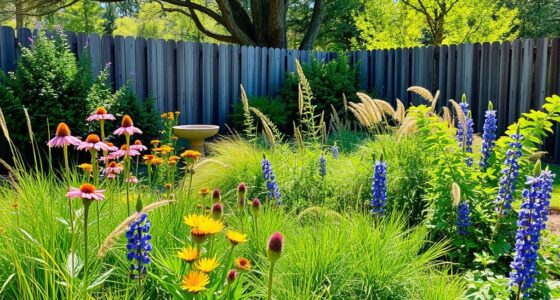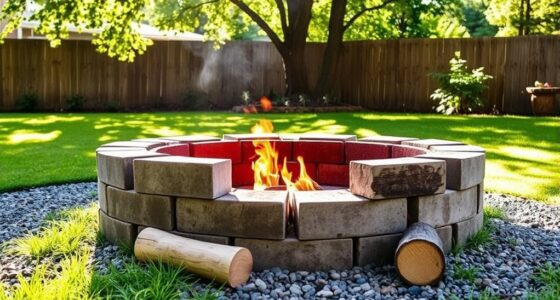Many beginners don’t realize that successful gardening involves more than just planting seeds. You need to understand soil preparation, including testing pH and nutrients, to give your plants a healthy start. Pest management, watering techniques, and adjusting for seasonal changes are also vital. Mistakes like overwatering or neglecting pruning can harm your plants. Keep learning about these hidden challenges, and you’ll find yourself growing a thriving garden more easily.
Key Takeaways
- Soil testing and proper preparation are crucial; skipping them can lead to poor plant growth and disease.
- Pest identification and natural management methods prevent damage and reduce reliance on chemicals.
- Consistent watering tailored to each plant’s needs boosts health and reduces stress.
- Regular pruning and companion planting improve plant vigor and ward off pests.
- Seasonal adjustments in watering and fertilizing optimize growth and prevent setbacks year-round.
The Hidden Challenges of Soil Preparation

While soil preparation might seem straightforward, hidden challenges can catch beginners off guard. One key step is soil testing, which helps you understand your soil’s pH and nutrient levels. Without it, you might add amendments that don’t address your soil’s actual needs, leading to poor plant growth. Composting techniques also matter—knowing how to create and use compost properly can improve soil fertility naturally. Rushing into planting without testing or enriching your soil can result in weak plants or disease problems. Additionally, neglecting to adjust your soil based on test results or compost quality can waste time and resources. Taking the time to test your soil and master composting techniques ensures you build a healthy foundation for your garden, setting you up for success from the start. Proper toilet maintenance can also prevent issues like clogged mechanisms that hinder effective flushing, which is crucial for maintaining a healthy garden environment.
Unexpected Pests and How to Manage Them

Even after preparing your soil carefully and adding the right nutrients, unexpected pests can still show up and threaten your garden’s health. The key is pest identification—recognizing what’s causing damage early. Look for telltale signs like chewed leaves, sticky residue, or holes. Once you identify the pest, you can use natural remedies to control them effectively. For example, insecticidal soap can target aphids, while neem oil helps against a range of pests without harming beneficial insects. Introducing beneficial insects like ladybugs can also naturally reduce pest populations. Keep a close eye on your plants, and act quickly at the first sign of trouble. Managing pests with natural remedies not only protects your garden but also keeps it safe and chemical-free. Understanding pest management techniques can help prevent infestations from becoming severe.
The Importance of Proper Watering Techniques

Proper watering is essential for healthy plant growth, as it guarantees your garden receives the right amount of moisture at the right times. Establishing a consistent watering schedule ensures your plants don’t dry out or become waterlogged. Using appropriate watering tools, like a watering can or hose with a spray nozzle, makes this easier and more efficient. Remember, different plants need different amounts of water; research their specific needs. To help you stay organized, here’s a quick guide:
| Plant Type | Watering Frequency |
|---|---|
| Flowering Plants | Every 2-3 days |
| Vegetables | Daily or every other day |
| Shrubs | Once a week |
| Succulents | Every 2 weeks |
| Lawns | 1-2 times weekly |
Proper watering techniques keep your garden thriving, and understanding the importance of watering schedules can further improve plant health.
Overcoming Common Plant Care Mistakes

Many common plant care mistakes can harm your garden’s health, but recognizing and correcting them can make a big difference. One mistake is neglecting proper pruning techniques, which can lead to overcrowding or disease. Regular pruning encourages healthy growth and airflow. Additionally, avoiding companion planting can prevent pests and improve plant well-being. Pair plants that benefit each other to naturally repel pests and boost growth. Overwatering or underwatering is another common slip-up; stick to consistent watering schedules suited for each plant’s needs. Being aware of AI’s impact on privacy and regulation is also crucial, as data security concerns can affect gardening tools that utilize smart technology. By understanding and fixing these errors, you foster a thriving garden. Keep an eye on your plants’ responses and adjust your care routines accordingly. With patience and attention, you’ll develop better habits that keep your garden healthy and vibrant.
Understanding Seasonal Changes and Their Impact

As the seasons change, so do the needs of your garden plants. Understanding seasonal changes helps you plan for effective seasonal planting and weather adaptation. In spring, you’ll want to plant crops suited to warmer weather, while fall requires selecting hardy varieties that withstand cooler temperatures. Recognizing how sunlight, temperature, and rainfall shift allows you to adjust watering and fertilizing schedules accordingly. For example, during hot summers, you may need to provide shade or extra water, and in winter, protect vulnerable plants from frost. By paying close attention to these seasonal cues, you can optimize your garden’s growth and avoid setbacks. Embracing these natural cycles guarantees your garden stays healthy and productive year-round. Understanding seasonal changes also enables you to better anticipate and manage the evolving needs of your garden, ensuring long-term success.
Frequently Asked Questions
How Do I Choose the Right Plants for My Climate?
To choose the right plants for your climate, start by researching plant compatibility with your local weather and soil conditions. Conduct soil testing to determine pH levels and nutrient content, helping you select plants suited for your soil. Focus on native species or those proven to thrive in your area, as they’ll adapt better and require less maintenance. This approach guarantees healthier growth and a more successful garden.
What Tools Are Essential for Beginner Gardeners?
Imagine a trusty trowel as your sword in the garden battlefield. You’ll need essential tools like a trowel, pruning shears, and gloves to help with soil preparation and pest control. A watering can keeps plants hydrated, while a garden fork helps aerate the soil. These basics set you up for success, making gardening manageable and enjoyable. With these tools, you’ll nurture healthy plants and keep pests at bay.
How Can I Prevent My Plants From Overwatering?
To prevent overwatering, follow watering tips like checking soil moisture before watering, ensuring you don’t pour when the soil feels wet. Improve soil drainage by using well-draining soil mixes and adding perlite or sand if needed. Water deeply but infrequently, allowing the top inch of soil to dry out between watering sessions. This helps roots breathe and prevents waterlogged roots, keeping your plants healthy and thriving.
When Is the Best Time to Start Gardening Outdoors?
Imagine the warm sun on your back as you prepare your garden bed. The best time to start outdoors is after the last frost, when soil warms up and is ready for planting. Make sure your soil is well-prepared with nutrients and free from pests. This way, your plants will thrive from the start, giving you a lush, vibrant garden that rewards your patience and effort.
How Do I Deal With Weeds Effectively?
To handle weed control effectively, start by removing weeds manually or using tools to dig them out completely. Apply mulching techniques around your plants to suppress new weed growth, retaining moisture and improving soil health. Regularly inspect your garden and pull weeds early before they seed. Consistent maintenance is key—staying vigilant keeps weeds at bay and promotes a healthy, thriving garden.
Conclusion
Gardening is like a dance—you’ll stumble at times, but each step teaches you something new. By understanding soil prep, managing pests, watering wisely, avoiding mistakes, and adapting to seasons, you’ll grow more confident with every season. Remember, every gardener starts with small, imperfect beginnings, but with patience and practice, your garden will flourish like a beautiful symphony. Keep learning, stay curious, and enjoy the rewarding journey ahead.









